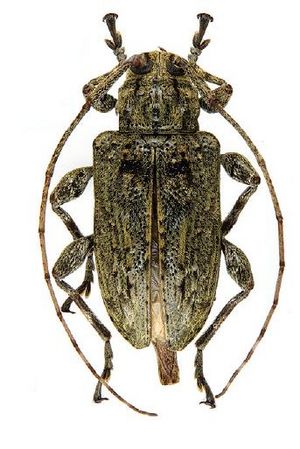Leptostylopsis cristatus facts for kids
Quick facts for kids Leptostylopsis cristatus |
|
|---|---|
 |
|
| Scientific classification | |
| Kingdom: | |
| Phylum: | |
| Class: | |
| Order: | |
| Family: | |
| Subfamily: |
Lamiinae
|
| Genus: |
Leptostylopsis
|
| Species: |
L. cristatus
|
| Binomial name | |
| Leptostylopsis cristatus Fisher, 1925
|
|
Leptostylopsis cristatus is a type of longhorn beetle. It belongs to a group of beetles called Lamiinae. A scientist named Fisher first described this beetle in 1925.
Longhorn beetles are known for their very long antennae. These antennae can sometimes be longer than their whole body!
Contents
What is a Longhorn Beetle?
Longhorn beetles are a big family of insects. They are also known as "Cerambycidae." There are over 35,000 different kinds of longhorn beetles all over the world. They come in many sizes and colors.
These beetles get their name from their antennae. Their antennae are usually very long. They use them to feel their way around. They also use them to find food and mates.
Where Do Longhorn Beetles Live?
Longhorn beetles live in many different places. You can find them in forests, woodlands, and even gardens. They are found on every continent except Antarctica.
Many species prefer to live near trees. This is because trees are important for their life cycle. Some beetles live inside the wood of trees. Others live on the bark or leaves.
What Do Longhorn Beetles Eat?
Most longhorn beetles eat plants. Their diet depends on their age. Larvae, which are young beetles, usually eat wood. They tunnel into tree trunks or branches. They can eat both living and dead wood.
Adult longhorn beetles often eat different things. Some eat tree sap or pollen. Others might nibble on leaves or flowers. They play a role in nature by helping to break down wood.
Life Cycle of a Longhorn Beetle
Like all beetles, longhorn beetles go through a complete metamorphosis. This means they change a lot during their life. They have four main stages: egg, larva, pupa, and adult.
Egg Stage
The life of a longhorn beetle starts as a tiny egg. Female beetles lay their eggs in cracks in tree bark. They might also lay them in dead wood. The eggs are usually very small and hard to see.
Larva Stage
When an egg hatches, a larva comes out. This larva is often called a "grub." It looks like a soft, white worm. The larva is the main eating stage. It tunnels deep into the wood.
Larvae can spend a long time in this stage. Some might live for several years. They grow bigger by eating wood. As they grow, they shed their skin several times. This is called molting.
Pupa Stage
After growing enough, the larva changes into a pupa. The pupa stage is a resting stage. The larva builds a special chamber inside the wood. It then transforms into a pupa.
During this stage, the beetle does not eat or move much. Inside the pupa, the larva's body changes. It slowly develops into an adult beetle. This stage can last from a few weeks to several months.
Adult Stage
Finally, the adult beetle comes out of the pupa. It chews its way out of the wood. Adult longhorn beetles are usually short-lived. They focus on finding a mate and laying eggs.
Adults are often seen flying around trees. They are important for reproduction. They help to continue the beetle's life cycle. Then, the whole process starts again.
See also
 In Spanish: Leptostylopsis cristatus para niños
In Spanish: Leptostylopsis cristatus para niños

